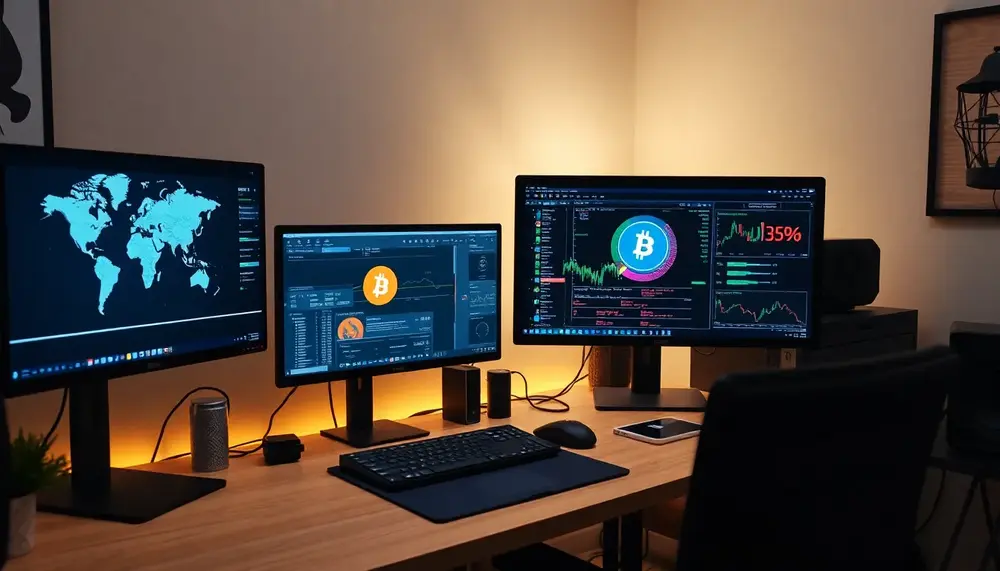Virtual private network
Virtual private network
Understanding Virtual Private Network (VPN) in Bitcoin Mining
A Virtual Private Network (VPN) is a crucial tool in the digital world, especially for Bitcoin miners. So, what exactly is a VPN and why is it important for Bitcoin Mining?
A VPN is a service that allows you to create a secure connection over the internet. It works by rerouting your internet connection through a separate server. This means your online activity stays private and anonymous, offering protection against hackers and snoopers.
Why is a VPN Important in Bitcoin Mining?
Now, you might wonder, "Why do I need a VPN for Bitcoin Mining?" To put it simply, it enhances the security of your Bitcoin Mining activity. You see, Bitcoin Mining requires a strong internet connection. The miners must solve complicated math problems to earn Bitcoins. This sensitive process, if not protected, can fall prey to cyber-attacks.
By using a VPN, your Bitcoin Mining activity is concealed. It prevents unwanted attention and secures your earned Bitcoins from theft. Perhaps the most appealing aspect of using a VPN is its ability to bypass geographical restrictions. If a mining pool or a specific coin becomes unavailable in your area, you can still access it using a VPN.
Choosing the Right VPN for Bitcoin Mining
When choosing a VPN for Bitcoin Mining, it's important to prioritize security, speed, and ease of use. A VPN with strong encryption is advisable to protect your digital ‘treasure’ - your Bitcoins. In addition, VPNs with higher speed are compulsory for efficient mining.
Half the battle is knowing what you need. So now that you are aware of the importance of VPNs in Bitcoin Mining, make sure you equip yourself with the best one. Happy mining!
Blog Posts with the term: Virtual private network

The article "Introduction to Zano Mining" provides a comprehensive guide for beginners on how to mine the privacy-focused cryptocurrency, Zano, efficiently by explaining its hybrid Proof-of-Work and Proof-of-Stake consensus mechanism. It covers essential tools such as mining hardware, software like...

Solana mining apps are software tools that help users mine Solana (SOL) cryptocurrency by utilizing their device's computational power to validate blockchain transactions, rewarding miners with SOL tokens. These apps vary in complexity and features, catering to both beginners and...

This guide provides a comprehensive overview of solo mining Verus Coin, covering everything from understanding the cryptocurrency and its unique Proof of Power consensus algorithm to setting up your mining rig with appropriate software. It emphasizes the rewards and challenges...

This article provides a comprehensive guide to mining Ravencoin using GPUs, covering essential steps such as selecting the right GPU and software, optimizing your setup for better performance, and joining a mining pool. It explains that Ravencoin uses the ASIC-resistant...

Monero is a privacy-focused cryptocurrency, and mining it can be profitable using NiceHash, which simplifies the process by allowing users to rent hashing power instead of setting up complex hardware. This guide covers everything from creating a NiceHash account to...

The article introduces a method of mining Ethereum (ETH) using Tether (USDT), highlighting the benefits such as stability, liquidity, and reduced risk. It provides a step-by-step guide on acquiring USDT, choosing a mining pool, setting up hardware and software for...

Monero is a privacy-focused cryptocurrency that can be mined using your computer's CPU or GPU without specialized hardware. To start mining, download and install the Monero GUI Wallet from getmonero.org, set it up in Advanced mode, configure the number of...

Mining pools allow cryptocurrency miners to collaborate, increasing their chances of earning rewards by combining computing power and sharing the profits based on contributions. Mining pool apps enhance this process with features like real-time monitoring, multi-account management, instant notifications, asset...

Cloud mining allows individuals to rent processing power for cryptocurrency mining, offering cost efficiency and global accessibility without the need for hardware investment. It provides scalability and democratizes Bitcoin mining, making it more accessible. Free BTC cloud mining enables users to...

Tron USDT mining leverages the Tron blockchain and Tether (USDT) to offer a stable, efficient, and scalable environment for cryptocurrency miners. This guide covers the fundamentals of Tron and USDT, highlights benefits like low transaction fees and high speed, and...

Crypto mining on Windows is popular due to its user-friendly interface, software compatibility, and strong community support. This article reviews top crypto mining software for Windows like Cudo Miner and NiceHash, highlighting features such as automatic coin switching, overclocking capabilities,...

This guide provides a comprehensive overview of mining USDT (Tether) using Coinbase Wallet, detailing the steps involved, potential challenges, and security measures. It explains the uses of USDT as a stablecoin in trading, remittances, hedging, and DeFi applications while highlighting...

Integrating with a mining pool allows individual miners to combine computational power for consistent rewards, and linking this setup with Coinbase streamlines converting mined coins into fiat currency securely. To integrate successfully, ensure you have the necessary tools like an...

Zano solo mining allows individuals to mine cryptocurrency independently, offering full rewards and greater privacy but requiring a higher initial investment in hardware. This guide covers setting up a Zano wallet, choosing the right hardware, and configuring mining software to...

